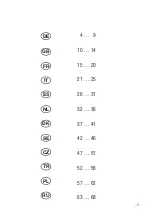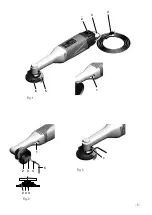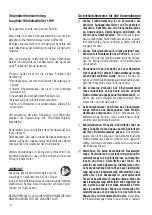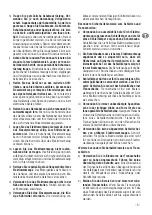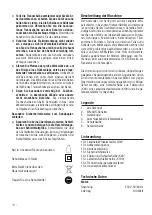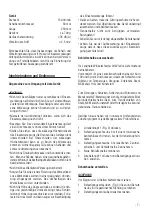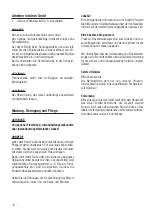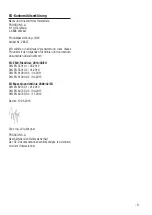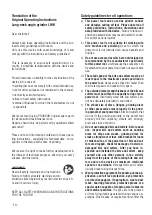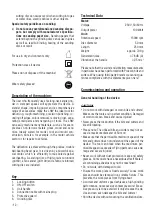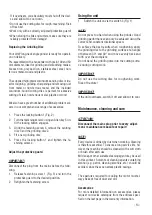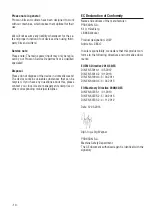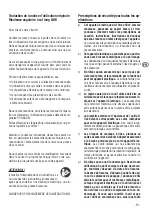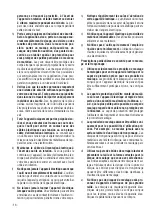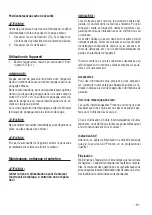
- 11 -
dust generated during the operation. If you are ex-
posed to loud noise for a long time, you may suffer
hearing loss.
i)
Keep other people at a safe distance away from
your work area. Anyone who enters the working
area must wear personal protective equipment.
Fragments of the work piece or broken bits and cut-
ters can fly away and cause injuries even beyond the
immediate area of work.
j)
Hold the device only by its insulated grip surfaces
if you perform work where the bits and cutters
could contact hidden power cables or your own
mains cable.
Contact with a live cable can energize
metal device parts and cause electric shock.
k)
Keep the mains cable away from rotating bits and
cutters.
If you lose control of the device, the mains
cable could be cut or snagged, and your hand or
your arm could get pulled into the rotating bits and
cutters.
l)
Never set down the power tool until the bits and
cutters come to a complete stop.
Turning bits and
cutters grab the depositing surface and pull the
power tool out of your control.
m)
Do not allow the power tool to run while you are
carrying it.
Your clothing could get snagged acci-
dentally in the rotating bits and cutters, causing the
power tool to pierce your body.
n)
Regularly clean the ventilation slits of your pow-
er tool.
The motor fan sucks dust into the housing
and a strong accumulation of metal dust can cause
electrical hazards.
o)
Do not use the power tool in the vicinity of com-
bustible materials
. Sparks could ignite these ma-
terials.
p)
Do not use bits and cutters that require liquid
coolants.
The use of water or other liquid coolants
can cause electric shock.
Additional safety guidelines on grinding and abrasive
cutting.
a)
Special safety guidelines on grinding and abra-
sive cutting:
b)
Use only the grinding tools approved for your
power tool and the protective guard designed for
these grinding tools.
Grinding tools that are not
designated for the power tool cannot be adequate-
ly guarded and are therefore unsafe.
c)
The protective guard must be attached securely to
the power tool and adjusted in such a way as to
achieve maximum safety, i.e. the smallest possi-
ble part of the grinding tool is open to the operator.
The protective guard is meant to protect the operator
from fragments and accidental contact with the grind-
ing tool.
d)
Grinding tools may only be used for the recom-
mended applications. For example: Never grind
with the lateral surface of a cutting disc.
Cutting
discs are intended for removing material with the
edge of the disc. Lateral forces on these grinding
tools can shatter them.
e)
Always use undamaged clamping flanges in the
correct size and shape for your selected sanding
disc.
Suitable flanges support the sanding disc and
reduce the danger of sanding disc breakage.
Flanges for cutting discs can differ from other sand-
ing disc flanges.
f)
Do not use worn sanding discs from larger power
tools.
Sanding discs for larger power tools are not
designed for higher rotational speeds of smaller
power tools and can shatter.
Further special safety guidelines on abrasive cutting:
a)
Avoid jamming the cutting disc or applying too
great contact pressure. Do not make excessively
deep cuts.
Overstressing the cutting disc increas-
es its load and its susceptibility to twisting or jam-
ming and thus the possibility of recoil or grinding
tool breakage.
b)
Avoid the area in front of and behind the rotating
cutting disc.
If you move the cutting disc in the
work piece away from you, recoil may catapult the
power tool with the rotating disc directly towards
you.
c)
If the cutting disc binds or if you interrupt work,
switch off the device and hold it still until the disc
has come to a complete stop. Never attempt to
pull the running cutting disc out of the cut, other-
wise recoil may occur.
Determine and eliminate the
cause for binding.
d)
Do not switch the power tool back on as long as it
is in the work piece. Allow the cutting disc to
reach its full rotational speed before carefully
continuing the cut.
Otherwise, the disc can get
snagged, jump out of the work piece or cause re-
coil.
e)
Support sheets or large work pieces to minimize
the risk of recoil caused by a jammed cutting disc.
Large work pieces can sag under their own weight.
The work piece must be supported on both sides of
the disc; namely near the separating cut as well as
at the edge.
f)
Be especially careful when making “pocket cuts”
in existing walls or other blind areas.
The dipping
GB
Содержание LHW
Страница 1: ...Langhals Winkelschleifer LHW Manual DE GB FR IT ES NL DK CZ SE TR PL RU ...
Страница 3: ...2 3 4 2 3 4 5 1 1 5 6 2 3 4 3 Fig 1 6 5 2 2 3 4 3 4 5 1 1 2 3 4 Fig 2 Fig 3 1 1 ...
Страница 69: ... 69 Notes ...
Страница 70: ... 70 Notes ...


